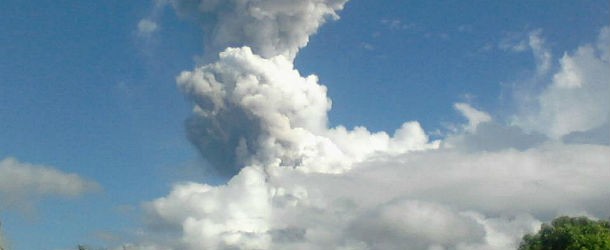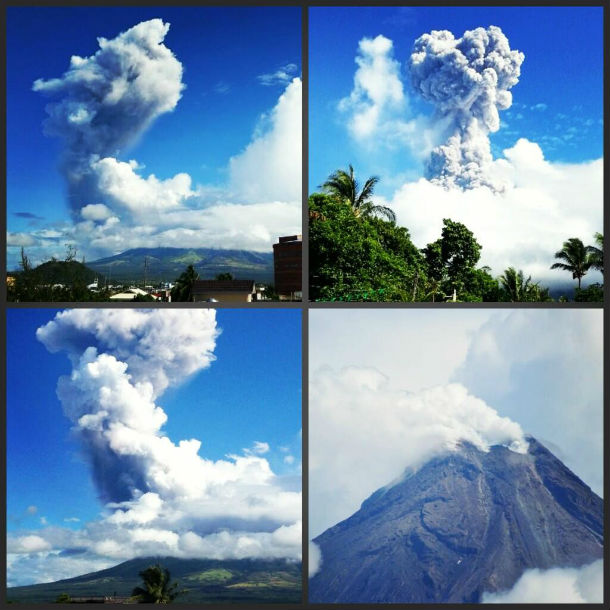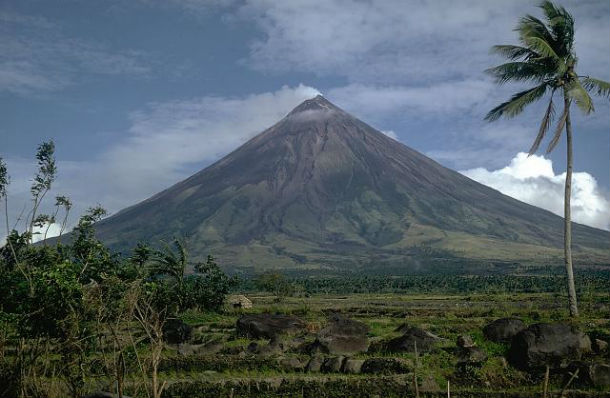Deadly ash eruption at Mayon volcano in Philippines

Philippine Institute of Volcanology and Seismology (PHIVOLCS) stated in the latest advisory report that Mayon volcano (13.2500°N, 123.6833°E) produced a small phreatic eruption early on May 7, 2013, which lasted 2 minutes 26 seconds. The agency stated that in the past 8-hr period, only one minor rockfall event was detected by the Mayon seismic network.

Mayon volcano phreatic explosions on May 7, 2013 (Credit: @tinabogs/noypistuff)
According to local media reports five people were killed and seven were injured as a result of a phreatic eruption at Mayon volcano in Philippines, which occurred during the morning hours on May 7, 2013. A tour guide who climbed up the Mayon volcano with seven other people on May 6, 2013 reported that three foreign tourists and a tour guide were killed due to the ash ejection.

Seismic and gas emission parameters remain within background levels and indicate no intensification of volcanic activity. With the above observations, PHIVOLCS still maintains Alert Level 0 over Mayon volcano, which means that no magmatic eruption is imminent. However, PHIVOLCS advises caution as small phreatic eruptions including small steam and ash explosions may occur suddenly with little or no warning. The public is strongly reminded of refraining from entry into the 6-kilometer radius Permanent Danger Zone (PDZ) due to the perennial threat of sudden steam-driven eruptions and rockfalls from the upper and middle slopes of the volcano.


National Disaster Risk and Management Council (NDRMC) reported that Mayon spewed ash as high as 500 meters above its crater and precipitated traces of ash in the areas west-northwest of the volcano, affecting Barangays Muladbucad, Guinobatan and Nabonton, Nasisi, Basag and Tambo, Ligao City, Albay, and areas upslope of these barangays. According to PHIVOLCS Director Renato Solidum, Jr. the morning event was essentially a hydrothermal or steamed driven explosion with not much pressure and no new magma yet, but once that steam is hot, there can be pressure and will have a shallow explosion.
At this point, PHIVOLCS agency could not be certain whether this shallow eruption would be followed by another one. In previous eruptions of Mayon, sometimes another ash explosion would happen but the interval would not be very regular so agency don’t know what would happen.
Geologic summary


Mayon’s frequent historical eruptions, recorded since 1616, have typically included powerful explosive activity accompanied by pyroclastic flows, mudflows, and lava flows that descended to the lower flanks of the volcano.
(Photo by Kurt Fredrickson/Smithsonian Institution)
Beautifully symmetrical Mayon volcano, which rises to 2462 m above the Albay Gulf, is the Philippines’ most active volcano. The structurally simple volcano has steep upper slopes averaging 35-40 degrees that are capped by a small summit crater. The historical eruptions of this basaltic-andesitic volcano date back to 1616 and range from strombolian to basaltic plinian, with cyclical activity beginning with basaltic eruptions, followed by longer term andesitic lava flows. Eruptions occur predominately from the central conduit and have also produced lava flows that travel far down the flanks. Pyroclastic flows and mudflows have commonly swept down many of the approximately 40 ravines that radiate from the summit and have often devastated populated lowland areas. Mayon’s most violent eruption, in 1814, killed more than 1200 people and devastated several towns.
Sources: PHIVOLCS, NDRMC, PhilStar, GVP
Featured image: Ash column seen above Mayon volcano on May 7, 2013 (Credit: PHIVOLC DOST)

Commenting rules and guidelines
We value the thoughts and opinions of our readers and welcome healthy discussions on our website. In order to maintain a respectful and positive community, we ask that all commenters follow these rules:
We reserve the right to remove any comments that violate these rules. By commenting on our website, you agree to abide by these guidelines. Thank you for helping to create a positive and welcoming environment for all.